
Dear Bird Folks,
You have often suggested that sunflower is the best seed to use in our bird feeders. But don’t the birds get bored with the same diet, day in and day out? Is there another food I could put out for the birds, just to spice things up?
– Jacob, Rutland, MA
You have the wrong guy, Jacob,
I’m the last person to ask about spicing up food. I was raised in an Irish household. Our idea of adding spice to food was to boil it just a little less. Besides, food boredom is a human dilemma. I don’t think it applies to animals. Ospreys eat fish every single day of their lives and I’ve never heard them complain. Cows eat grass 365, and they’re totally cool with it. I laugh when I walk through the pet food section of Stop & Shop. The aisle is three miles long and each shelf features items totally geared to attract people, not animals. My childhood dog lived to be 100, or so it seemed, and my mother only fed it whatever was on sale that particular week. And she never did anything special to the dog’s food…except, boil it.
Because of its price, availability, nutritional value and appeal, sunflower is the number one seed to offer in a backyard feeder. If you only have one feeder, sunflower is the way to go. But that doesn’t mean you shouldn’t try something different in a different feeder. Thistle (niger) feeders are especially designed for those brilliant (male) American Goldfinches. But now that the finches have molted into their drab winter outfits, the excitement over these birds has waned a bit. It might be time to experiment with something else. One food I like to put out in the fall is peanuts. Peanuts are appealing to a variety of birds, but jays, titmice and woodpeckers are especially fond of them. Peanuts are packed with protein, which makes them a good alternative to suet. And unlike suet, and all of those gross foods in the pet aisle, peanuts are cruelty-free…and they smell a million times better.
Typically, peanuts are sold in two forms – in the shell and out of the shell. Surprisingly, peanuts in the shell, the ones that look like Mr. Peanut (but without the hat and monocle) are more expensive. Many species will come for peanuts in the shell, but the jays can’t get enough of them. You don’t even need to buy a special feeder to keep the jays happy. Just place a pile of peanuts out on a tray or on your porch railing, and the jays will be munching on them before you can get back into the house. Yes, I’m aware that a certain percentage of the people reading this aren’t big Blue Jay fans (that percentage is probably 99.99%), but I think you’ll have a different appreciation of these colorful birds if you give them their very own peanut tray. Now, instead of the jays flying in and scaring away all the “good birds,” they will be scaring away each other. It’s very entertaining.
Because jays will land on a feeder and grab way more than their fair share, most folks consider them to be a bunch of “flying pigs.” But the truth is they are only stocking up for the winter, much like we do with firewood, good books and whatever we need to make hot toddies with. By taking advantage of the fall’s bounty, jays routinely cache extra seeds and acorns for leaner times. It is thought that a significant percentage of our oak trees are “planted” by Blue Jays. Don’t you feel bad about cursing these hardworking birds now? Nah, I didn’t think so.
Shelled peanuts (without the shell) are a little different and actually do need to be used in specialty feeders. These feeders are usually made of wire mesh, which has been molded into the shape of a tube. When I first bought one I complained that the holes in the wire were too small for the peanuts to fit through. While this is true, it’s actually a good thing. Instead of flying away with an entire nut, the birds are forced to nibble a bit at a time. This not only offers us better viewing of the birds, but because they only take small bites, you will be using fewer peanuts. This is a plus for everyone…except for peanut sellers like me and, of course, Jimmy Carter.
When it comes to offering shelled peanuts vs. the Mr. Peanut-looking ones, there are a few things to keep in mind. First, birds like both types, so don’t get too hung up on that. But the peanuts in the shell cost more, plus a lot of folks don’t like having empty shells in their yards. Peanuts without shells are neater and cheaper, but they also have a downside. Without the shells for protection, these “naked” peanuts can become moldy in damp weather and mold is bad for birds, people and just about everything else, except maybe types of cheese. If you use shelled peanuts, you should place a rain guard over your feeder and routinely inspect it for signs of mold. If you find any mold, dump the peanuts into the trash. Or, if you don’t want to waste them, pretend they’re a new kind of nutty Gorgonzola and serve them at your next cocktail party.
While sunflower seed is always my first choice for a bird feeder, Jacob, there is nothing wrong with trying something new and different. Just don’t buy the dreaded “mixed birdseed.” Too many of those mixes contain ingredients birds aren’t interested in and blending them all together doesn’t fool anybody. And if you end up with a pile of unwanted seeds, there isn’t much you can do with those useless things, except maybe boil them. But then you’d probably only attract my relatives.